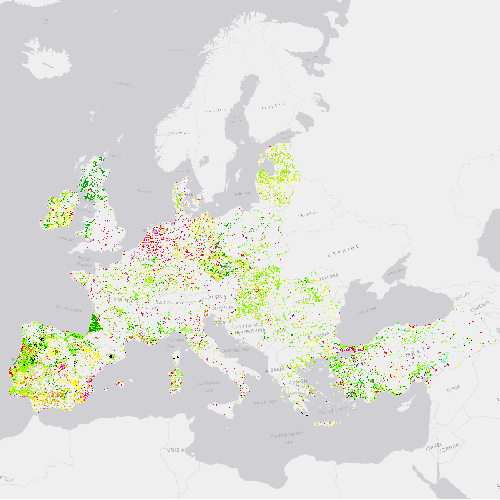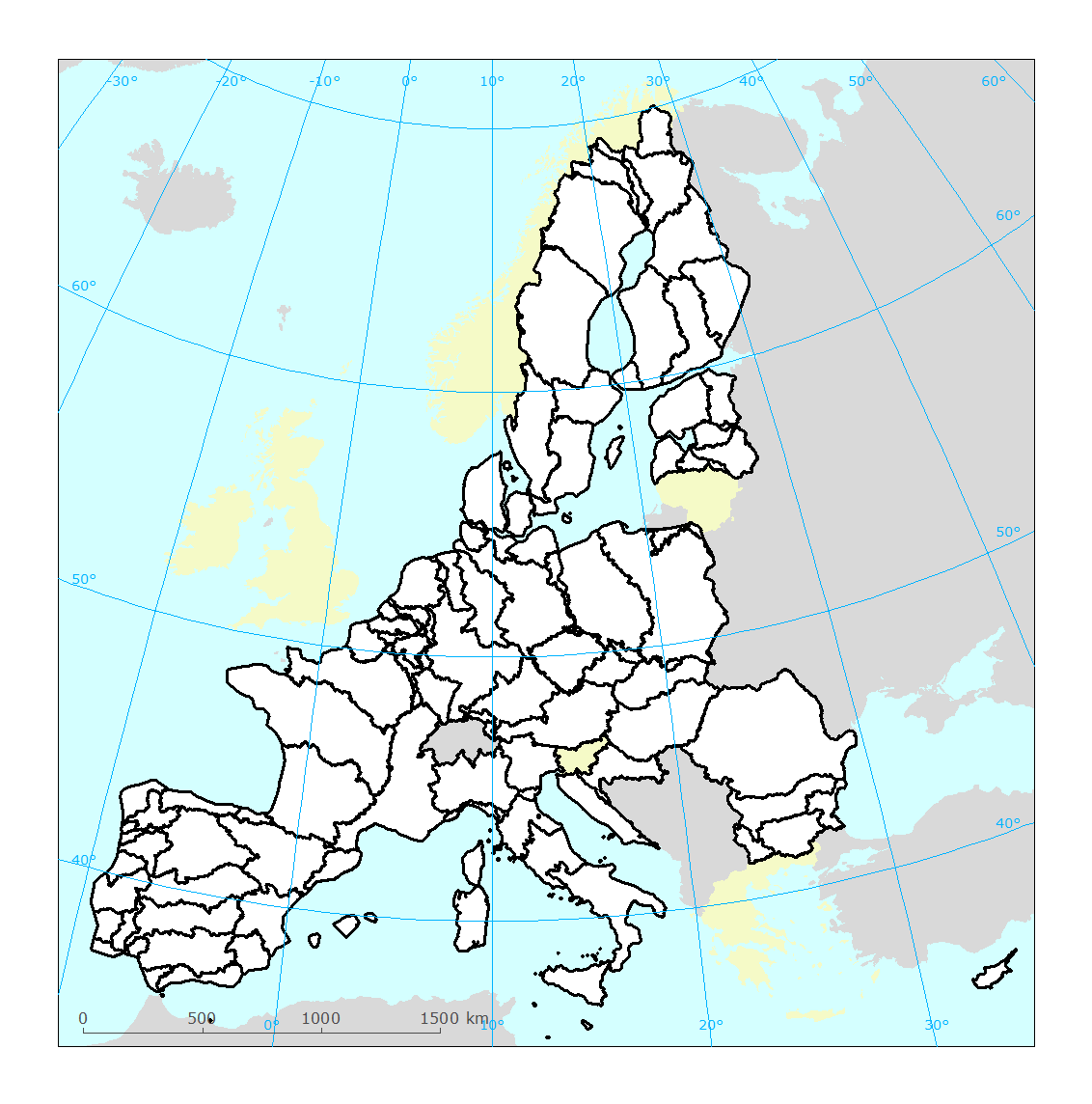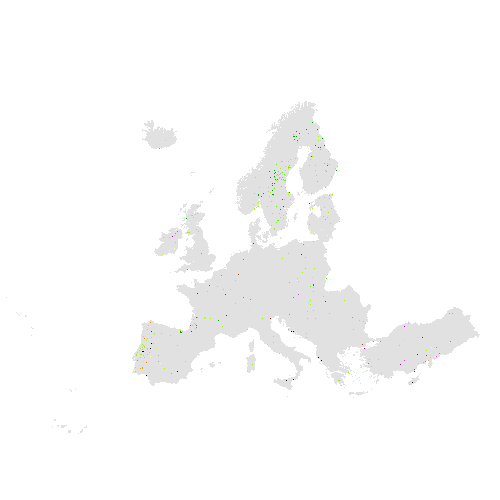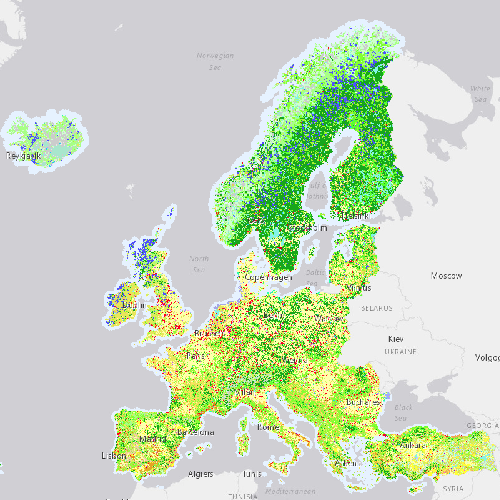Spatialite
Type of resources
Available actions
Topics
INSPIRE themes
Keywords
Contact for the resource
Provided by
Years
Formats
Representation types
Update frequencies
status
Scale
Resolution
-

Member States provide an annual assessment of air quality in comparison to EU air quality thresholds. Commission Decision 2004/461/EC provides a questionnaire to be used by the Member States for the annual reporting under the Framework Directive and the related four Daughter Directives 1999/30/EC, 2000/69/EC, 2002/3/EC and 2004/107/EC. Member States have to divide their entire territory into zones. Zones can be regarded as the primary territorial units for assessment and management of air quality under the air quality directives. Consequently, unambiguous definition of all zones is needed. Member States have employed different approaches for the definition of their zones. Some Member States have divided their territory into a single set of zones serving all pollutants. Other Member States have defined a single base set of zones and modified some of the zones for the application to particular pollutants. Where a Member State has distinguished different sets of zones in relation to health protection and ecosystem/vegetation protection respectively, a single location can be situated in several zones, e.g. in a zone defined for all pollutants except lead and in another, larger zone defined for lead. More information about EU air quality standards is available on the DG Environment web site at http://ec.europa.eu/environment/air/quality/standards.htm. Pursuant to Article 22 of Directive 2008/50/EC, Member States may notify to the Commission when in their opinion the conditions are met in a given zone or agglomeration for postponing the attainment deadline for the limit values for nitrogen dioxide and benzene, or for being exempt from the limit values for PM10. More information is available at: http://ec.europa.eu/environment/air/quality/legislation/time_extensions.htm . Additional information is available in The annual technical overview and analysis of the reports submitted by Member States (http://acm.eionet.europa.eu/databases/aq-questionnaire/annual_reports_aqq.html). Zones are designated for the following pollutants: B – Benzene; BaP – Benzo(a)pyrene; C – Carbon Monoxide; L – lead; AsCdNi – Heavy metals: Arsenic, Cadmium, Nickel; NH – Nitrogen Dioxide for human protection; NV – NOx for vegetation protection; O – ozone; PM10 – particulate matter less than 10 microgrammes; PM25 – particulate matter less than 2.5 microgrammes; SE – SO2 for ecosystems protection; SH – SO2 for human protection.
-

This data set contains the administrative boundaries at country level of the world and is based on the geometry from EBM v12.x. of EuroGeographics for the members of Eurogeographics, the Global Administrative Units Layer (2015) from FAO (UN) and geometry from the Turkish National Statistical Office. This dataset consists of 2 feature classes (regions, boundaries) per scale level and there are 6 different scale levels (100K, 1M, 3M, 10M, 20M and 60M). The public dataset is available at 1M, 3M, 10M, 20M, 60M, while the full dataset at 100K is restricted. This metadata only refers to the full dataset (polygon) at 100k (CNTR_RG_100K_2016 in the GISCO database) and shall only be used internally by the EEA. This metadata has been slightly adapted from the original metadata file provided by Eurostat (European Commission) and is to be used only for internal EEA purposes. For reference, the original metadata file provided by ESTAT (CNTR_2016.xml) is provided together with the dataset. The public dataset is available for download on http://ec.europa.eu/eurostat/cache/GISCO/distribution/v2/countries/countries-2016-files.html
-

Member States provide an annual assessment of air quality in comparison to EU air quality thresholds. Commission Decision 2004/461/EC provides a questionnaire to be used by the Member States for the annual reporting under the Framework Directive and the related four Daughter Directives 1999/30/EC, 2000/69/EC, 2002/3/EC and 2004/107/EC. Member States have to divide their entire territory into zones. Zones can be regarded as the primary territorial units for assessment and management of air quality under the air quality directives. Consequently, unambiguous definition of all zones is needed. Member States have employed different approaches for the definition of their zones. Some Member States have divided their territory into a single set of zones serving all pollutants. Other Member States have defined a single base set of zones and modified some of the zones for the application to particular pollutants. Where a Member State has distinguished different sets of zones in relation to health protection and ecosystem/vegetation protection respectively, a single location can be situated in several zones, e.g. in a zone defined for all pollutants except lead and in another, larger zone defined for lead. More information about EU air quality standards is available on the DG Environment web site at http://ec.europa.eu/environment/air/quality/standards.htm. Pursuant to Article 22 of Directive 2008/50/EC, Member States may notify to the Commission when in their opinion the conditions are met in a given zone or agglomeration for postponing the attainment deadline for the limit values for nitrogen dioxide and benzene, or for being exempt from the limit values for PM10. More information is available at: http://ec.europa.eu/environment/air/quality/legislation/time_extensions.htm . Additional information is available in The annual technical overview and analysis of the reports submitted by Member States (http://acm.eionet.europa.eu/databases/aq-questionnaire/annual_reports_aqq.html). Zones are designated for the following pollutants: B – Benzene; BaP – Benzo(a)pyrene; C – Carbon Monoxide; L – lead; AsCdNi – Heavy metals: Arsenic, Cadmium, Nickel; NH – Nitrogen Dioxide for human protection; NV – NOx for vegetation protection; O – ozone; PM10 – particulate matter less than 10 microgrammes; PM25 – particulate matter less than 2.5 microgrammes; SE – SO2 for ecosystems protection; SH – SO2 for human protection. ************ In this revision 2, Montenegro was added to the SE and NV datasets. ************
-

A Groundwater Body (GWB) under the Water Framework Directive (WFD) Art. 2 is defined as a distinct volume of groundwater within an aquifer or aquifers, whereas an aquifer is defined as a geological layer with significant groundwater flow. This definition of a GWB allows a wide scope of interpretations. EU Member States (MS) are under obligation to report the GWBs including the results of the GWB survey periodically according to the schedule of the WFD. Reportnet is used for the submission of GWB data to the EEA by MS and includes spatial data as GIS polygons and GWB characteristics in an XML schema. The WISE provisional reference GIS WFD Dataset on GWBs combines spatial data consisting of several shape files and certain GWB attributes in a single table submitted by the MS according to Art. 13. The GWBs are divided into horizons, which represent distinct vertical layers of groundwater resources. All GWBs assigned to a certain horizon from one to five are merged into one shape file. GWBs assigned to horizons six or seven are combined in a single further shape file. Another two shape files comprise the GWBs of Reunion Island in the southern hemisphere and the GWBs from Switzerland as a non EU MS, all of which assigned to horizon 1. The dbf tables of the shape files include the columns “EU_CD_GW” as the GWB identifier and “Horizon” describing the vertical positioning. The polygon identifier “Polygon_ID” was added subsequently, because some GWBs consist of several polygons with identical “EU_CD_GW”even in the same horizon. Some further GWB characteristics are provided with the Microsoft Excel file “GWB_attributes_2012June.xls” including the column “EU_CD_GW”, which serves as a key for joining spatial and attribute data. There is no corresponding spatial data for GWBs in the Microsoft Excel table without an entry in column “EU_CD_GW”. The spatial resolution is given for about a half of the GWBs in the column “Scale” of the xls file, which is varying between the MS from 1 : 10,000 to 1 : 1,000,000 and mostly in the range from 1 : 50,000 to 1 : 250,000. The processing of some of the GWB shape files by GIS routines as clip or intersect in combination with a test polygon resulted in errors. Therefore a correction of erroneous topological features causing routine failures was carried out. However, the GWB layer includes a multitude of in parts very tiny, distinct areas resulting in a highly detailed or fragmented pattern. In certain parts topological inconsistencies appear quite frequently and delineation methodologies are currently varying between the MS in terms of size and three dimensional positioning of GWBs. This version of the dataset has to be considered as a first step towards a consistent GWB picture throughout Europe, but it is not yet of a sufficient quality to support spatial analyses i.e. it is not a fully developed reference GIS dataset. Therefore, the layer is published as a preliminary version and use of this data is subject to certain restrictions outlined in the explanatory notes. It should be underlined that the methodology used is still under discussion (Working Group C -Groundwater) and is not fully harmonised throughout the EU MS. For the external publication the whole United Kingdom has to be removed due to licensing restrictions.
-

Corine Land Cover Change 1990-2000 (CHA9000) is one of the Corine Land Cover (CLC) datasets produced within the frame the Copernicus Land Monitoring Service referring to changes in land cover / land use status between the years 1990 and 2000. CHA is derived from satellite imagery by direct mapping of changes taken place between two consecutive inventories, based on image-to-image comparison. CLC service has a long-time heritage (formerly known as "CORINE Land Cover Programme"), coordinated by the European Environment Agency (EEA). It provides consistent and thematically detailed information on land cover and land cover changes across Europe. CLC datasets are based on the classification of satellite images produced by the national teams of the participating countries - the EEA members and cooperating countries (EEA39). National CLC inventories are then further integrated into a seamless land cover map of Europe. The resulting European database relies on standard methodology and nomenclature with following base parameters: 44 classes in the hierarchical 3-level CLC nomenclature; minimum mapping unit (MMU) for status layers is 25 hectares; minimum width of linear elements is 100 metres. Change layers have higher resolution, i.e. minimum mapping unit (MMU) is 5 hectares for Land Cover Changes (CHA), and the minimum width of linear elements is 100 metres. The CLC service delivers important data sets supporting the implementation of key priority areas of the Environment Action Programmes of the European Union as e.g. protecting ecosystems, halting the loss of biological diversity, tracking the impacts of climate change, monitoring urban land take, assessing developments in agriculture or dealing with water resources directives. CLC belongs to the Pan-European component of the Copernicus Land Monitoring Service (https://land.copernicus.eu/), part of the European Copernicus Programme coordinated by the European Environment Agency, providing environmental information from a combination of air- and space-based observation systems and in-situ monitoring. Additional information about CLC product description including mapping guides can be found at https://land.copernicus.eu/user-corner/technical-library/. CLC class descriptions can be found at https://land.copernicus.eu/user-corner/technical-library/corine-land-cover-nomenclature-guidelines/html/.
-

The dataset contains information on the European river basin districts delineated for the 1st River Basin Management Plans (RBMP) under the Water Framework Directive (WFD). The information was reported to the European Commission under the Water Framework Directive (WFD) reporting obligations. The dataset compiles the available spatial data related to the 1st RBMPs which were due in 2010 (hereafter WFD2010). See http://rod.eionet.europa.eu/obligations/521 for further information on the WFD2010 reporting. It was prepared to support the reporting of the 2nd RBMPs due in 2016 (hereafter WFD2016). See http://rod.eionet.europa.eu/obligations/715 for further information on the WFD2016 reporting. The data reported in WFD2010 were updated using data reported in WFD2016, whenever the spatial objects are identical in 2010 and 2016. For WFD2010 objects, some information may be missing, if the objects no longer exist in the 2nd River Basin Management Plans, and were not reported in WFD2016. This dataset updates the information published in "WISE River basin districts (RBD) - version 1.4, Jun. 2011" (http://sdi.eea.europa.eu/catalogue/srv/eng/catalog.search#/metadata/3be396a5-dded-4492-a620-f42d9f4aba5c) Relevant concepts: River basin district: The area of land and sea, made up of one or more neighbouring river basins together with their associated groundwaters and coastal waters, which is the main unit for management of river basins. River basin: The area of land from which all surface run-off flows through a sequence of streams, rivers and, possibly, lakes into the sea at a single river mouth, estuary or delta.
-

Corine Land Cover Change 2012-2018 (CHA1218) is one of the Corine Land Cover (CLC) datasets produced within the frame the Copernicus Land Monitoring Service referring to changes in land cover / land use status between the years 2012 and 2018. CLC service has a long-time heritage (formerly known as "CORINE Land Cover Programme"), coordinated by the European Environment Agency (EEA). It provides consistent and thematically detailed information on land cover and land cover changes across Europe. CLC datasets are based on the classification of satellite images produced by the national teams of the participating countries - the EEA members and cooperating countries (EEA39). National CLC inventories are then further integrated into a seamless land cover map of Europe. The resulting European database relies on standard methodology and nomenclature with following base parameters: 44 classes in the hierarchical 3-level CLC nomenclature; minimum mapping unit (MMU) for status layers is 25 hectares; minimum width of linear elements is 100 metres. Change layers have higher resolution, i.e. minimum mapping unit (MMU) is 5 hectares for Land Cover Changes (CHA), and the minimum width of linear elements is 100 metres. The CLC service delivers important data sets supporting the implementation of key priority areas of the Environment Action Programmes of the European Union as e.g. protecting ecosystems, halting the loss of biological diversity, tracking the impacts of climate change, monitoring urban land take, assessing developments in agriculture or dealing with water resources directives. CLC belongs to the Pan-European component of the Copernicus Land Monitoring Service (https://land.copernicus.eu/), part of the European Copernicus Programme coordinated by the European Environment Agency, providing environmental information from a combination of air- and space-based observation systems and in-situ monitoring. Additional information about CLC product description including mapping guides can be found at https://land.copernicus.eu/user-corner/technical-library/. CLC class descriptions can be found at https://land.copernicus.eu/user-corner/technical-library/corine-land-cover-nomenclature-guidelines/html/.
-

The dataset contains information on the European groundwater bodies delineated for the 2nd River Basin Management Plans (RBMP) under the Water Framework Directive (WFD). The information was reported to the European Commission under the Water Framework Directive (WFD) reporting obligations. The dataset compiles the available spatial data related to the 2nd RBMPs due in 2016 (hereafter WFD2016). See http://rod.eionet.europa.eu/obligations/715 for further information on the WFD2016 reporting. Relevant concepts: Groundwater body: 'Body of groundwater' means a distinct volume of groundwater within an aquifer or aquifers. Groundwater: All water which is below the surface of the ground in the saturation zone and in direct contact with the ground or subsoil. Aquifer: Subsurface layer or layers of rock or other geological strata of sufficient porosity and permeability to allow either a significant flow of groundwater or the abstraction of significant quantities of groundwater.
-

Corine Land Cover 2012 (CLC2012) is one of the Corine Land Cover (CLC) datasets produced within the frame the Copernicus Land Monitoring Service referring to land cover / land use status of year 2012. CLC service has a long-time heritage (formerly known as "CORINE Land Cover Programme"), coordinated by the European Environment Agency (EEA). It provides consistent and thematically detailed information on land cover and land cover changes across Europe. CLC datasets are based on the classification of satellite images produced by the national teams of the participating countries - the EEA members and cooperating countries (EEA39). National CLC inventories are then further integrated into a seamless land cover map of Europe. The resulting European database relies on standard methodology and nomenclature with following base parameters: 44 classes in the hierarchical 3-level CLC nomenclature; minimum mapping unit (MMU) for status layers is 25 hectares; minimum width of linear elements is 100 metres. Change layers have higher resolution, i.e. minimum mapping unit (MMU) is 5 hectares for Land Cover Changes (LCC), and the minimum width of linear elements is 100 metres. The CLC service delivers important data sets supporting the implementation of key priority areas of the Environment Action Programmes of the European Union as e.g. protecting ecosystems, halting the loss of biological diversity, tracking the impacts of climate change, monitoring urban land take, assessing developments in agriculture or dealing with water resources directives. CLC belongs to the Pan-European component of the Copernicus Land Monitoring Service (https://land.copernicus.eu/), part of the European Copernicus Programme coordinated by the European Environment Agency, providing environmental information from a combination of air- and space-based observation systems and in-situ monitoring. Additional information about CLC product description including mapping guides can be found at https://land.copernicus.eu/user-corner/technical-library/. CLC class descriptions can be found at https://land.copernicus.eu/user-corner/technical-library/corine-land-cover-nomenclature-guidelines/html/.
-

The dataset contains information on the European river basin districts delineated for the 2nd River Basin Management Plans (RBMP) under the Water Framework Directive (WFD). The information was reported to the European Commission under the Water Framework Directive (WFD) reporting obligations. The dataset compiles the available spatial data related to the 2nd RBMPs due in 2016 (hereafter WFD2016). See http://rod.eionet.europa.eu/obligations/715 for further information on the WFD2016 reporting. Relevant concepts: River basin district: The area of land and sea, made up of one or more neighbouring river basins together with their associated groundwaters and coastal waters, which is the main unit for management of river basins. River basin: The area of land from which all surface run-off flows through a sequence of streams, rivers and, possibly, lakes into the sea at a single river mouth, estuary or delta.
 RUC Geo-Data catalogue
RUC Geo-Data catalogue